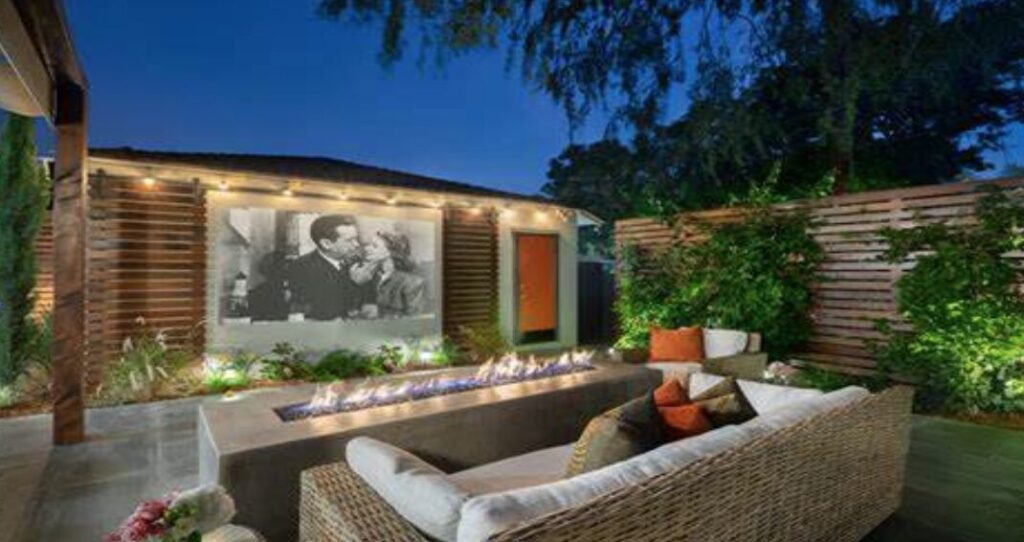A cozy home theater is a great way to bring family and friends together to unwind, bond, and enjoy favorite movies, TV shows, sporting events, and more. Transforming a room or section of your home into a home theater can be a rewarding project for any budget, and add value to your home, too.
Read on as we take a closer look at what you need to consider when designing the right setup for your next family movie night.
The Right Space
Ideally, a home theater should be assembled in a room that can be darkened easily and is away from the main hustle and bustle of the house to minimize distractions and keep excess noise from disrupting others.
Basements, dens, or attics can work well since they’re usually enclosed and require minimal modifications to create that theater-like ambiance. A corner of a living room can also work, with strategic furniture placement and blackout curtains helping create an immersive experience.
Whatever space you choose, the area should be large enough to accommodate seating, a screen, and the necessary projection equipment.
Comfortable Seating
Comfort is a top priority in a home theater. Seating should cater to long movie marathons and provide ample space for the entire family to lounge, sprawl, and stretch out, a benefit usually not possible in a traditional movie theater!
Plush reclining chairs like those found in premium theaters allow each viewer to adjust their seating to their taste for individual comfort. In addition, sectional sofas work well for larger groups, and bean bags and floor cushions are perfect for families with younger kids.
If space isn’t an issue, you might consider a mix of seating to accommodate different sizes, ages, and types of viewing events. It’s also good practice to arrange the seating in tiers if possible so everyone has a clear view of the screen and access to their spot. If that’s not an option, ensure that there’s enough space between seats to move easily.
The Screen: HDTV or Projector
Depending on your budget and space, those designing their home theater can choose between a high-definition TV or a projector and screen setup. A high-definition TV 65 inches or larger is a versatile option, with excellent picture quality and more flexibility for placement if your space is limited. For larger rooms, a projector with a screen is an ideal choice for a truly immersive cinematic experience. Look for a projector with a resolution of at least 1080p or 4K and at least 2,000 lumens for brightness.
Whether you choose a TV or projector, consider the room size and viewing distance to determine the ideal screen size. Mount your TV or projector screen at eye level for optimal viewing, as placing a screen too high or low can cause neck strain.
Sound System & Acoustics
Elevate your home theater with a next-level sound system.
For the ultimate home theater, try a surround sound system that includes a receiver, several speakers strategically placed around the room, and a subwoofer for true theater-style audio.
Soundbars are a space-saving alternative to surround sound systems that offer a significantly richer sound quality than traditional TV speakers. They’re also generally easy to install and can provide a more integrated look.
For a cleaner, more minimalist setup, look for wireless surround sound or soundbar options, which can eliminate the hassle of unattractive cables.
Don’t forget the acoustic quality of your space, which is just as important as your sound system. Home theaters are much smaller than traditional theaters, and too many sound waves bouncing around the room can result in audio that sounds muddy and hard to hear. Acoustic wall panels can reduce echo and reverb for a cleaner, crisper sound experience. Likewise, thick carpets or floor rugs are not only an added comfort but can dampen sound and keep outside noise to a minimum.
The Right Light
Good lighting sets the mood and prevents eye strain without causing glare on the screen. Dimmable overhead or recessed lights allow viewers to adjust the brightness as needed, while wall sconces provide ambient lighting without glare. Another popular solution is to install LED strip lights behind the screen or along baseboards for both added safety while moving around in the dark and a real-theater touch.
Additionally, depending on the location of your home theater, you may want to invest in light-blocking curtains or shades to keep out ambient light during daytime viewing.
Special Touches
Finish off your space by customizing your home theater with unique additions that reflect your family and tastes.
- – Create a concession stand: For some, movie theater snacks are almost as big a reason to go to the movies as the films. Create an area for popcorn, drinks, movie candy, and other favorite treats that’s easily accessible for everyone.
- – Extra comfort: Outfit your theater with soft pillows and comfy blankets for marathon watch parties.
- – Storage: When not in use, keep your home theater organized and tidy. Consider large baskets for pillows and blankets, a storage ottoman for remotes or gaming consoles, or a credenza with cabinets and drawers for DVDs.
- – Add artwork: Set the tone for your home theater with framed posters of favorite movies or actors for an authentic look.
A cozy home theater for family enjoyment requires thoughtful design and attention to detail. Choosing the right space, investing in the right seating and technology, and adding personal touches can transform an ordinary room into the perfect atmosphere
Outdoor Adventures: Designing a Backyard Oasis for Family Fun
Kid-Friendly Kitchen Ideas: Making Cooking and Dining Fun for the Whole Family
Time-Saving Techniques to Help Streamline Your Household Chores


